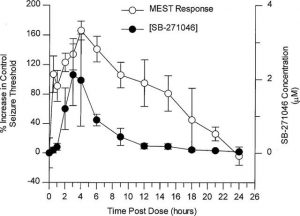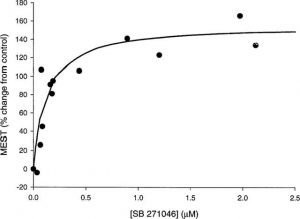
| Size | Price | Stock | Qty |
|---|---|---|---|
| 5mg |
|
||
| 10mg |
|
||
| 25mg |
|
||
| 50mg |
|
||
| 100mg |
|
||
| 250mg | |||
| 500mg | |||
| Other Sizes |
Purity: ≥98%
SB271046 HCl (SB 271046; SB-271046), the hydrochloride salt of SB 271046, is a novel, potent, selective and orally bioactive 5-HT6 receptor antagonist with potential anticonvulsant activity. It has 200 times more selectivity than other 5-HT receptor subtypes and inhibits 5-HT6 with a pKi of 8.9.
| Targets |
5-HT6 Receptor ( pKi = 8.92-9.02 ); 5-HT1D Receptor ( pKi = 6.55 ); 5-HT1A Receptor ( pKi = 6.35 ); 5-HT1B Receptor ( pKi = 6.05 ); 5-HT1F Receptor ( pKi = 5.95 );
5-HT2A Receptor ( pKi = 5.62 ); 5-HT2B Receptor ( pKi = 5.41 ); 5-HT7 Receptor ( pKi = 5.39 ); 5-HT4 ( pKi = 5.27 ); 5-HT1E ( pKi < 4.99 ); Human 5-HT2C Receptor ( pKi = 5.73 ) |
||
|---|---|---|---|
| ln Vitro |
|
||
| ln Vivo |
|
||
| Enzyme Assay |
SB271046 Hcl is an effective, pKi of 8.9, selective, and oral 5-HT6 receptor antagonist. IC50 Value: 8.9(pKi). A sulfonamidal benzothiophene derivative, SB 271046 hydrochloride has been demonstrated to function as a selective 5-HT6 antagonist, with pKi values of 9.02-8.92, 6.55, 6.35, 6.27, 6.05, 5.95, 5.76, 5.73, 5.62, 5.55, 5.41, 5.39, 5.27, and < 4.99 for 5-HT6, 5-HT1D, 5-HT1A, D3, 5-HT1B, 5-HT1F, α1B, 5-HT2C, 5-HT2A, D2, 5-HT2B, 5-HT7, 5-HT4 and 5-HT1E, respectively. It is also > 200-fold selective over 55 other receptors, enzymes, and ion channels.
Radioligand binding [1] Radioligand binding was carried out as described (Hirst et al., 2000). In brief, radioligand binding was performed on membranes from HeLa cells stably transfected with the human 5-HT6 receptor (see above) and striatal tissue from adult rats (Sprague-Dawley, 200–250 g), adult pigs (from a local abattoir) and human caudate putamen tissues (from non-identifiable patients aged 64–76 years, whose cause of death was non-neurological). Membranes were incubated with 1 nM [125I]-SB-258585 (Hirst et al., 2000) or 2 nM [3H]-LSD for 45 min at 37°C. Non-specific binding was defined by the inclusion of 10 μM methiothepin and the assay was terminated by rapid filtration through Whatman GF/B filters. For receptor selectivity studies on other 5-HT receptors, details of the radioligands used and assay conditions are given in Hirst et al. (2000). SB-271046 was also tested in a further 55 binding assays by CEREP |
||
| Animal Protocol |
|
||
| References | |||
| Additional Infomation |
SB-271046, potently displaced [(3)H]-LSD and [(125)I]-SB-258585 from human 5-HT(6) receptors recombinantly expressed in HeLa cells in vitro (pK(i) 8.92 and 9.09 respectively). SB-271046 also displaced [(125)I]-SB-258585 from human caudate putamen and rat and pig striatum membranes (pK(i) 8.81, 9.02 and 8.55 respectively). SB-271046 was over 200 fold selective for the 5-HT(6) receptor vs. 55 other receptors, binding sites and ion channels. In functional studies on human 5-HT(6) receptors SB-271046 competitively antagonized 5-HT-induced stimulation of adenylyl cyclase activity with a pA(2) of 8.71. SB-271046 produced an increase in seizure threshold over a wide-dose range in the rat maximal electroshock seizure threshold (MEST) test, with a minimum effective dose of < or =0.1 mg kg(-1) p.o. and maximum effect at 4 h post-dose. The level of anticonvulsant activity achieved correlated well with the blood concentrations of SB-271046 (EC(50) of 0.16 microM) and brain concentrations of 0.01-0.04 microM at C(max). These data, together with the observed anticonvulsant activity of other selective 5-HT(6) receptor antagonists, SB-258510 (10 mg kg(-1), 2-6 h pre-test) and Ro 04-6790 (1-30 mg kg(-1), 1 h pre-test), in the rat MEST test, suggest that the anticonvulsant properties of SB-271046 are likely to be mediated by 5-HT(6) receptors. Overall, these studies demonstrate that SB-271046 is a potent and selective 5-HT(6) receptor antagonist and is orally active in the rat MEST test. SB-271046 represents a valuable tool for evaluating the in vivo central function of 5-HT(6) receptors. [1]
The present study shows that SB-271046 produces potent and long-lasting anticonvulsant activity in the rat MEST test, a model of previously reported utility for studying the role of serotonergic pathways in seizure regulation (e.g. Upton et al., 1998). Since SB-271046 is a very selective 5-HT6 receptor antagonist (Bromidge et al., 1999; Routledge et al., 1999), the anticonvulsant properties of SB-271046 are likely to be mediated by blockade of 5-HT6 receptors. This is further supported by the demonstrated close correlation between the pharmacokinetic and pharmacodynamic profiles of the compound and the presently observed anticonvulsant activity of other selective 5-HT6 receptor antagonists, SB-258510 (Bromidge et al., 1999; pKi at human 5-HT6 receptor 9.2) and the chemically distinct agent Ro 04-6790 (Sleight et al., 1998). Overall, these data suggest that the MEST test may provide a robust model of in vivo 5-HT6 receptor function, and also illustrate that SB-271046 is a potent and orally active 5-HT6 receptor antagonist. However, the magnitude of these anti-seizure effects was modest in comparison to that of known anti-epileptic drugs For example, using identical test conditions, agents such as carbamazepine can elevate seizure threshold by >1200% (Upton et al., 1997) as compared to the maximum increase of only 132 and 166% produced by SB-258510 and SB-271046, respectively. This low level of anticonvulsant efficacy associated with 5-HT6 receptor blockade probably contributes to the apparent lack of dose-dependency for SB-271046, SB-258510 and Ro 04-6790 in the MEST test, since the anticonvulsant activity of SB-271046 is clearly related to the level of exposure in blood. Therefore, the relevance of this observation to the possible clinical utility of SB-271046 in the treatment of epilepsy is, at this stage, unclear. Taken together, these data demonstrate that SB-271046 is a potent, selective and orally active 5-HT6 receptor antagonist. This compound provides a useful tool for further elucidating the physiological function of 5-HT6 receptors in vivo. [1] |
| Molecular Formula |
C20H22N3O3S2CL.HCL
|
|
|---|---|---|
| Molecular Weight |
488.45092
|
|
| Exact Mass |
487.06
|
|
| Elemental Analysis |
C, 49.18; H, 4.75; Cl, 14.52; N, 8.60; O, 9.83; S, 13.13
|
|
| CAS # |
209481-24-3
|
|
| Related CAS # |
SB 271046; 209481-20-9
|
|
| PubChem CID |
6918455
|
|
| Appearance |
White to light brown solid powder
|
|
| Hydrogen Bond Donor Count |
3
|
|
| Hydrogen Bond Acceptor Count |
7
|
|
| Rotatable Bond Count |
5
|
|
| Heavy Atom Count |
30
|
|
| Complexity |
656
|
|
| Defined Atom Stereocenter Count |
0
|
|
| InChi Key |
RMXZRJYGJMSDQK-UHFFFAOYSA-N
|
|
| InChi Code |
InChI=1S/C20H22ClN3O3S2.ClH/c1-13-16-11-14(21)3-6-19(16)28-20(13)29(25,26)23-15-4-5-18(27-2)17(12-15)24-9-7-22-8-10-24;/h3-6,11-12,22-23H,7-10H2,1-2H3;1H
|
|
| Chemical Name |
5-chloro-N-(4-methoxy-3-piperazin-1-ylphenyl)-3-methyl-1-benzothiophene-2-sulfonamide;hydrochloride
|
|
| Synonyms |
|
|
| HS Tariff Code |
2934.99.9001
|
|
| Storage |
Powder -20°C 3 years 4°C 2 years In solvent -80°C 6 months -20°C 1 month Note: Please store this product in a sealed and protected environment, avoid exposure to moisture. |
|
| Shipping Condition |
Room temperature (This product is stable at ambient temperature for a few days during ordinary shipping and time spent in Customs)
|
| Solubility (In Vitro) |
|
|||
|---|---|---|---|---|
| Solubility (In Vivo) |
Solubility in Formulation 1: ≥ 2.5 mg/mL (5.12 mM) (saturation unknown) in 10% DMSO + 40% PEG300 + 5% Tween80 + 45% Saline (add these co-solvents sequentially from left to right, and one by one), clear solution.
For example, if 1 mL of working solution is to be prepared, you can add 100 μL of 25.0 mg/mL clear DMSO stock solution to 400 μL PEG300 and mix evenly; then add 50 μL Tween-80 to the above solution and mix evenly; then add 450 μL normal saline to adjust the volume to 1 mL. Preparation of saline: Dissolve 0.9 g of sodium chloride in 100 mL ddH₂ O to obtain a clear solution. Solubility in Formulation 2: ≥ 2.5 mg/mL (5.12 mM) (saturation unknown) in 10% DMSO + 90% (20% SBE-β-CD in Saline) (add these co-solvents sequentially from left to right, and one by one), clear solution. For example, if 1 mL of working solution is to be prepared, you can add 100 μL of 25.0 mg/mL clear DMSO stock solution to 900 μL of 20% SBE-β-CD physiological saline solution and mix evenly. Preparation of 20% SBE-β-CD in Saline (4°C,1 week): Dissolve 2 g SBE-β-CD in 10 mL saline to obtain a clear solution. View More
Solubility in Formulation 3: ≥ 2.5 mg/mL (5.12 mM) (saturation unknown) in 10% DMSO + 90% Corn Oil (add these co-solvents sequentially from left to right, and one by one), clear solution. Solubility in Formulation 4: 1% methylcellulose: ~30 mg/mL |
| Preparing Stock Solutions | 1 mg | 5 mg | 10 mg | |
| 1 mM | 2.0473 mL | 10.2365 mL | 20.4729 mL | |
| 5 mM | 0.4095 mL | 2.0473 mL | 4.0946 mL | |
| 10 mM | 0.2047 mL | 1.0236 mL | 2.0473 mL |
*Note: Please select an appropriate solvent for the preparation of stock solution based on your experiment needs. For most products, DMSO can be used for preparing stock solutions (e.g. 5 mM, 10 mM, or 20 mM concentration); some products with high aqueous solubility may be dissolved in water directly. Solubility information is available at the above Solubility Data section. Once the stock solution is prepared, aliquot it to routine usage volumes and store at -20°C or -80°C. Avoid repeated freeze and thaw cycles.
Calculation results
Working concentration: mg/mL;
Method for preparing DMSO stock solution: mg drug pre-dissolved in μL DMSO (stock solution concentration mg/mL). Please contact us first if the concentration exceeds the DMSO solubility of the batch of drug.
Method for preparing in vivo formulation::Take μL DMSO stock solution, next add μL PEG300, mix and clarify, next addμL Tween 80, mix and clarify, next add μL ddH2O,mix and clarify.
(1) Please be sure that the solution is clear before the addition of next solvent. Dissolution methods like vortex, ultrasound or warming and heat may be used to aid dissolving.
(2) Be sure to add the solvent(s) in order.
 |
 |